Rawcliffe
Red cliff or bank, Old Scandinavian rauthr + klif: Rawcliffe East Riding of Yorkshire. Routheclif c.1080
A Dictionary of English Place-Names, Oxford University Press
Part of a flat countryside, with Lincolnshire only six miles away, it stands on the River Aire. The busy road from Goole bounds Rawcliffe's fine park before passing through the heart of the village, where many old houses and a modern church are gathered round a spacious green shaded by trees.
It was the home of one of Yorkshire's oddities, Jimmy Hurst, who lived here in George the Third's day and sleeps in the churchyard. He wore yellow boots, a rainbow waistcoat, and a hat nine feet round, and lived in a house near the river. He made a pair of wings and tried to fly, but his most remarkable invention was a coach like a Chinaman's hat on wheels. It was the wonder of all who saw it as he drove up to London, where he met the king. For over 90 years he was one of the queerest of all Yorkshiremen, and when he died, his coffin was carried by twelve old ladies, a Scotsman with a bagpipe and a Yorkshire fiddler accompanying them.
The King's England, edited by Arthur Mee
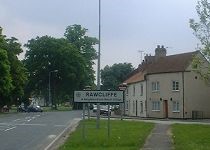
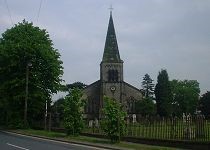

Rawcliffe is one of the prettiest villages in the area and consists of pubs, nice houses and a church all standing around a large village green. There is a fair on the green once each year. The River Aire runs peacefully round the back of the village and the riverbank forms a nice sign-posted walk to Goole. One of the local pubs used to have a quiz which was free to enter, had generous prizes and you even got a free pie and pea supper in the process.


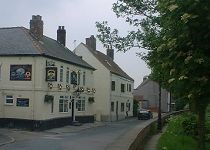
From Selby Abbey to the West Riding County Council
There is a pleasing simplicity and continuity at the core of Rawcliffe's history from 1069-1919. For in 1069 it was one of the estates given to Selby Abbey by William the Conqueror at its foundation. Through the subsequent centuries bequest (and probably purchase) strengthened the Selby connection. In time Rawcliffe became to Selby as Chequers to 10 Downing Street. For the Abbot built here a Manor House that was both a "holiday home" for the monks and great house for the Abbot. By a wise interpretation of the Rule most large monasteries had such a place where from time to time the monks could enjoy a "change of air" and some modest relaxation from the strictness of the monastic life. We can imagine some hard-worked monk at Selby murmuring to himself "only three more weeks and I"m off to Rawcliffe". Clearly Rawcliffe was a good place to be for there are records of important visitors staying there with the Abbot. But this holiday atmosphere did not prevent the Abbots from showing a continuing concern for both the economic and spiritual well-being of the Community. The financial problems of a Mediaeval Monastery are fascinating. Basically they needed money to pay for the raw materials and the work-force without which their increasingly ambitious building programmes would fail. That sometimes centuries would pass between the beginning and finishing of some great enterprise was almost entirely due to lack of money. For the great estates with which an Abbey like Selby was endowed, though they could produce food with which to feed the great household of the Abbey, did not by themselves produce money. Hence the great rivalry between the monasteries (notably between Selby and St. Mary's, York) to ports establish on their estates. These not only increased the opportunities of selling their own produce, but also, more importantly, gave a cash income from tolls and dues.
That Rawcliffe is on the Aire at a point where it is still reasonably navigable and has dry access by a long established road to inland Yorkshire made it an obvious place for a port. The Poll Tax returns of 1379 show that Rawcliffe was, for those days, a sizeable place and this prosperity must have been based on trade rather than agriculture. Without the help of any large single contribution from a nobleman they paid £2/8/8. The residents included one "schypmanne" and two ladies called "Avelline". The survival of documents from the past is very haphazard but we know that in 1322 "William de Howden of Rawcliffe and John son of Ranulph de Roucliff were given a licence to trade - but with the condition that they did not communicate with the Scots or the men of Flanders".
Rawcliffe was part of that ancient Royal Estate which made up the "spirituality of Snaith" (which was why the King could give it to Selby) and so was always part of the Parish of Snaith. But nonetheless, for over 900 years there has been a place of worship at Rawcliffe. The first chapel was licensed in 1078 but this may have been simply a room in or adjacent to the Monk's House. But in the 14th Century permission is given that the people at Rawcliffe "should have in their Chapel newly built, a baptismal font, but without prejudice to the Mother Church of Snaith". This Chapel was necessary, we are told, "by reason the same parochians cannot resorte to their paroche churche many tymes for the weteness of the ground and grete inundations of waters".
The 1379 Poll Tax tells us of "Master John, Chaplain of Rawcliffe" who must have a strong claim to be the first "Vicar" of Rawcliffe whose name is known to us. With the passage of time some "well disposed people" gave "certain parcells of land towards the levinge of the incumbents thereof".
The "Old Days" lasted longer in Rawcliffe than elsewhere. For with the Dissolution of the Monasteries in 1539 the last Abbot of Selby became transformed into the first Squire of Rawcliffe. He had made his peace with Henry VIII and emerged with a pension of £100 and ownership of Rawcliffe Hall with its "nine rooms, namely, Hall, Great Parlour, Buttery, Kitchen, Larder, Milkhouse and Brewhouse on the ground floor and two Chambers above". The old Abbot's death (and burial at Snaith) in 1558 must have seemed like the end of an era. Yet the pattern set by Selby over nearly five hundred years of a resident landlord concerned with both the economic and spiritual well-being of the community was going to survive for nearly another four hundred years.
In 1558 the Abbot's estate at Rawcliffe was purchased by John Boynton. The family prospered quietly and this meant the building of a new house to the east of the village (on the site of the present Rawcliffe Hall) in the 17th Century style to replace the now hopelessly out of date mediaeval house. This new house had three storeys: on the ground floor was the Hall, Dining Room, Drawing Room Study, Library, Kitchen, Pantry and Service Room; the second floor had six chambers with Closets and Dressing Rooms, and a further "chamber up the back stairs", on the third floor was the "Men's Chamber" and the "Clarks Chamber" and six Garretts opening off the long gallery.
The Boynton era lasted until the very end of the 18th Century and saw another major attempt to develop the port, and for a time between 1720 and 1780, Rawcliffe became an important trade centre. The main trade would seem to be from small vessels that took the products of the West Riding to Hull, but there was also a trade to London and further afield. And as in the previous age, the spiritual needs of the people were not forgotten.
The late 17th Century sees a succession of acts of generosity by the Boyntons. Sir John Boynton (the builder of the new house) gave a Silver Chalice to the church in 1684. His brother Francis who had left Yorkshire for a merchant's life in London in 1694, bequeathed £500 to the Chapel of Rawcliffe together with lands in Rawcliffe and Newland with which to endow a school. And Matthew Boynton, the youngest of the three brothers, who succeeded Sir John at Rawcliffe Hall (for Francis no doubt was doing too well in London to come home) built and endowed almshouses for four poor widows and left an endowment of £20 per year for the benefit of the Minister of the Chapel at Rawcliffe. Matthew died in 1700 and we are told that his widow "Mrs Judith Boynton rebuilt the present beautiful chapel at her sole expense."
From 1794 onwards for "Boynton" read "Creyke". The actual succession is a complex tale for, for a number of generations, the estates had passed through the female side with the husband then taking the name of "Boynton". But Ralph Creyke, who married the heiress of Rawcliffe in 1772 traced his ancestry back to the Danes. This family with its headquarters at Marton Hall, near Bridlington, had been an important part of the Yorkshire land-owning squirearchy for centuries. He had no intention of abandoning his surname.
So in 1794, when Matthew Boynton died, Ralph Creyke and his wife Jane and their family came to Rawcliffe. The Creykes seem to have been both richer and livelier than the Boyntons. And they very much followed in tradition of their Selby and Boynton predecessors in caring for the economic and spiritual well-being of the neighbourhood.
The second and third Ralph Creykes at Rawcliffe were both noted agriculturalists. As Sir Tatton Sykes transformed the Wolds with new farming methods, so Ralph Creyke "transformed the face of the Marshland area from swampy wet peatland to fertile arable land". His son (1813-1858) made considerable use of the method of warping by which the waters of the river are allowed, under controlled conditions, to flood the land so that the rich soil they are carrying is deposited on the land.
The fourth Ralph Creyke (1849-1908) however, focussed his energies on the industrial and commercial expansion of the neighbourhood. His agriculturalist father had, in the spirit of the family, welcomed the Railway to Rawcliffe in 1847. There is hardly an enterprise linked to the expansion of Goole in which his son's name does not appear. He worked hard to ensure that there were sea-going ships based in Goole. In his spare time he was also Member of Parliament for the neighbourhood. But side-by-side with this commercial acumen went a real commitment to the well-being of the village. In 1842 Ralph Creyke (the 3rd) was the principal subscriber to the building of the new church. And in 1908 it was Ralph Creyke (the 4th) who extended it with a fine new chancel. Similarly in 1824, 1854 and 1875 varying Creykes played a significant part in the founding (or helping with the founding) of schools. In 1897 Rawcliffe Hall was almost totally destroyed by fire and promptly rebuilt in great style. The Architect was Walter H.Brierly of York.
In 1908 Ralph Creyke died. His funeral marked the end of an era as surely as that of the last Abbot of Selby exactly three hundred and fifty years earlier. Surprisingly, despite his creation of a Creyke Chapel in Rawcliffe Church and his father's burial there, the decision was taken that the burial should be with his ancestors in Marton Church. The funeral procession to the special train at Rawcliffe Station led by the Chief Constable, and with the whole village taking part dramatically represents the wealth and confidence of Edwardian England. At first it is not so easy to see why it was a turning point. For now a fifth Ralph Creyke lived at Rawcliffe Hall with his widowed Mother and his Brother. But in 1914 came the Great War and both brothers were officers in France. Edward the younger brother was killed but Ralph returned safely. But not to Rawcliffe for long. "The new squire," I"m told by one who knew him "went in for night-clubbing in London". In 1919 suddenly the whole estate was sold. Rawcliffe Hall and the acres around were bought by the West Riding County Council. The house was to be used as a home for the mentally handicapped and the land was divided into small holdings for returning soldiers and a number of fine houses built. The distinctive style can best be seen in the "White Houses" along the Rawcliffe-Goole road. Alas, few of these small holdings flourished and they have now been for the most part absorbed into larger units. Major Ralph Creyke went to live in London. There are no links between the Creykes and Rawcliffe except that a great nephew of the last Ralph Creyke (who lives in Ireland) bears the barren title of "Lord of the Manor of Rawcliffe".
This apparently inexplicable flight is part of a pattern. In parish after parish in the Diocese of Sheffield after centuries of peaceful succession the gentry sold up and fled in the years immediately after the Great War.
The Church and the Clergy
Until 1824 (or even perhaps 1842) Rawcliffe was part of the great parish of Snaith. That the Vicar of Snaith since 1910 has been the Patron of Rawcliffe and so had had the prime responsibility of choosing the Vicar witnesses to that link. But nonetheless Rawcliffe Church has had much the same sort of history as an ordinary parish. There have been three (or perhaps four) churches in the village and they seem all to have been on the same site. The first was that "new built" by the Abbot of Selby round about 1350 in which, perhaps for the first time, a Font was allowed so that the children could be baptised locally and so escape the journey to Snaith. This ancient Chapel nearly perished at the Reformation when all "Chantry Chapels" were being done away with because they, allegedly, encouraged superstition. Yet Rawcliffe was spared "so that parishioners should cristen and have all manner of sacraments ministered there, saving burying". That was in 1540. One and fifty years later devotion destroyed the old Chapel when, around 1700, the widowed Mrs Judith Boyton "rebuilt the present beautiful Chapel at her sole expense".
In 1754, at last, the grievance about burials was put to rights when one of the Enclosure Acts both provided land for a burial ground and financial compensation to the Vicar of Snaith for the loss of funeral fees. One can"t help feeling that this was the issue, rather than the "wetness of the ground" that through the centuries had kept all burials at Snaith!
In 1841 the brave decision was taken that the now populous village needed a new and bigger church. A popular firm of local architects, Hurst and Moffatt (who were later to build Goole Parish Church) produced plans for a church with three galleries to seat 700 people and cost £1,840. 1842 was not a good year for church building and it is difficult to be really enthusiastic about any of Hurst and Moffatt's churches. Yet it stands well on the village green and by 1851, as the Census Records show had over 500 people through its doors on a Sunday.
To us today the 20th Century decision to extend the church by the building of a chancel in a totally different style seems ill-advised. I"m led to believe that the intention was eventually to rebuild the whole church in the style of the new chancel, but events worked against this.
Clearly the fourth Ralph Creyke expected his family to be at Rawcliffe for centuries to come. After the great fire of 1897 the Hall was rebuilt bigger, grander and more splendid than before. And the new chancel, though it was no doubt intended to meet the liturgical needs of its day - nearly every church by 1910 had a large robed choir and that needed choir stalls and they needed a chancel - was also designed to be a Creyke family burial Chapel. After 150 years the family had apparently decided that they now belonged to Rawcliffe and not Marton, for the new church was built in 1908 - the year that Ralph Creyke died. His son's disinterest in Rawcliffe, the Great War, and then the sale of the Creyke estates has meant that the curious amalgamation has become acceptable through three quarters of a century's familiarity.
Since the Middle Ages there must always have been someone who was responsible for "the Cure of Souls" of the people of Rawcliffe. And though strictly speaking that person was the Vicar of Snaith in practice the "cure" has usually been exercised by a Chaplain or Curate appointed by either the Abbot of Selby or, after the Reformation, by first the Proprietor of the Snaith Peculiar and then by the Vicar of Snaith.
From the earliest times no doubt the Abbot of Selby appointed the "Chaplain" or "Curate" at Rawcliffe. And so as it grew into a proper parish the Abbot's successor, the Proprietor of the Peculiar of Snaith, became the Patron and so Rawcliffe has the same succession of "Yarburghs" and "Deramores" as Snaith and Whitgift. But this stopped in 1910. For in that year the Ecclesiastical Commissioners were prepared to increase the benefice income but, by a rule of those days, they were not able to do this if a parish had a lay person as Patron. So in 1910 the Patronage was transferred to the Vicar of Snaith, who has preserved the ancient link between Snaith and Rawcliffe by appointing the Vicar of Rawcliffe since 1910. But Rawcliffe is a completely independent parish. The Vicar (now the Rector) of Snaith has no other rights in the parish than that of nominating the Vicar.
Rivers, Rectors and Abbots, David Lunn - Bishop of Sheffield, 1990
Postcards
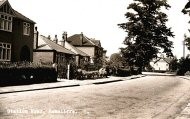

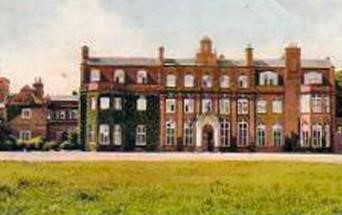
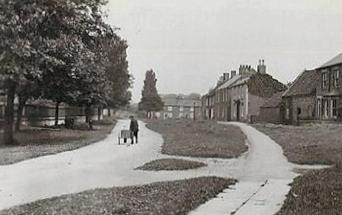
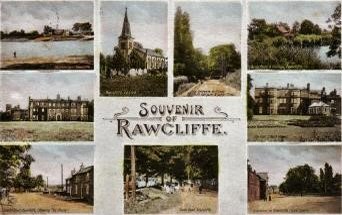
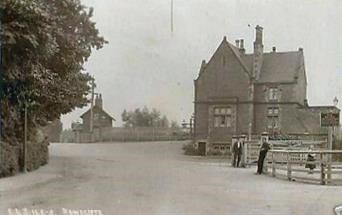
Visitor Comments
Posted by Robert on 18/12/2007
My father Leonard Haeness was born in Rawcliffe in 1908. He was one of the first babies to be christened in the newly built transept as reported in the parish magazine. He lived in Bell Lane and later on Riverside. My grandfather Charles William served through World War I in the 4th Battalion KOYLI and is buried with my grandmother Beatrice in the local cemetery. My uncle Eric still lives in Goole and I think my cousin Boyd lives in Goole. Does anyone remember or have any information on the family or on the 4th Battalion? Thanks.
Posted by Corby on 27/08/2008
I am trying to find information about Nego House, Rawcliffe. In the 1901 census my wife's great-grandfather Ralph Morris and his family lived there. Ralph was Nego Firelighter foreman. His sons Walter and Henry were railway engine cleaners. Sons, John, Albert and Arthur were firelighter makers. The rest of the family were mother Sarah (nee Wood) also Lilian and Rose.
Posted by Dorothy on 15/06/2009
My grandmother was born in Rawcliffe, being the daughter of Robert RUSBY. Robert, his wife Sarah and her parents (Richard and Sarah HILL) are all buried in the churchyard, near the door. I visited there in 1999, hoping to find out more about my ancestors, but didn't have any luck, as I wasn't there long enough. Grandma was Kate Rusby and she married Thomas George Craven from Goole.
Posted by Cliff on 22/07/2009
I was born and raised in Rawcliffe and went to Rawcliffe and Snaith schools. My first job was apprentice riveter at Craggs Shipyard, Old Goole. I worked for Jack Peacock who had a coal business at the west end as well as both Turners and Rostrons paper mills. I worked on the river board and Frank Morley was the foreman. I have great memories of Rawcliffe and vividly remember getting barred from the Craykes Arms by Harry the landlord for riding my motorbike into the pub. I now live in Wakefield but until November 2008 my mother still lived in Rawcliffe.
Posted by Wendy on 30/08/2009
I have photocopies of marriage certificates from the Registers for the following, free to anyone if interested. Goole Library have BMD details for Goole and surrounding villages on microfilm along with a lot of other info, well worth a visit.
William Henry Harrison 21 to Emily Dobson 21, 1885 Rawcliffe
Campbell William Kirkpatrick 35 to Jane Butterill 22, 1893 Rawcliffe
Fred Spivey 21 to Mary Taylor 19, 1890 Rawcliffe
Thomas Mapplebeck 28 to Harriet Chalker 22, 1858 Rawcliffe
Posted by Wendy on 30/08/2009
Is anyone researching or belong to the CAWOOD and YOUNG families in Rawcliffe? In particular Hannah Cawood married John Young 1863. Hannah had several children before her marriage to John Young, does anyone know if she was married before? Her daughter Elizabeth Cawood (also known as Young) married John Clayton of Patrington/Keyingham but was working in Rawcliffe on the 1881 census living with Brookes family. They married but as yet not found the details. They then left Rawcliffe for a life in Staddlethorpe/Gilberdyke where they outlived their lives and had family. Is Cawood related to Caward in Rawcliffe? Thanks.
Posted by Robert on 30/08/2009
The people Wendy mentions are in my family tree. I have contacted her directly.
Posted by CA on 23/01/2010
I worked at Rawcliffe Hall on night duty in 1971-72. I remember nurses Pugh, Annis, Sylvia(?), sister Jean(?) and sister Holdsworth. One nurse also had a local taxi service. We used to have pantomimes and dances with visitors from other hospitals
Posted by Mel on 18/09/2010
Looking for details on the KIRKPATRICK family, Campbell, William and Charles. Thanks.
Posted by Robert on 22/09/2010
Campbell William Kirkpatrick married, first, my great-great-grandmother's sister Emma Ledger in 1877, and second, Jane Butterill in 1893 after Emma died. Jane died in 1894 and Campbell in 1901. Campbell and Emma had seven children I know of: Ellen (b. 1877) who married John W.K. Strachan and died in Leeds in 1946, Charles (b. 1878) who had lupus and died in 1909, Louisa (b. 1880) who married Henry Corner in Leeds and lived in Dewsbury, Arthur (c1881-1984), William (b. 1885) who married Sarah E. Robinson, Ann (b. 1886) and George (b. c1889).
One of William's children, Wilfred, became an accomplished Arabic speaker and government advisor and was murdered in Pakistan as reported in the Times 7 April 1965. There were also two articles about him in the Goole Times in July 2009 relating to the history of Goole Grammar School.
Posted by Gary on 08/10/2010
I have already been in contact with Robert who has given me the Kirkpatrick detail above. I am the great-grandson of Ellen Strachan (nee Kirkpatrick) who was the eldest child of Campbell William Kirkpatrick and married John W.K. Strachan in 1898. I would appreciate any further details on the Kirkpatrick/Ledger family.
Posted by Carl on 20/11/2010
My grandmother was Helen Strachen, her mother was Ellen, married to John Kirkpatrick. I am interested as I now am working in Goole.
Posted by Sharon on 16/02/2014
Just stumbled across this as searching for my husband's uncle Wilfred Kirkpatrick who was murdered in April 1965 in Pakistan when he worked for British government as an envoy! My husband's father was George Kirkpatrick, Wilfred's brother… anyone have any more information on this? Thanks.
Posted by Robert on 19/02/2014
The Kirkpatricks, like me, descend from John Ledger (1815-1880) and Sarah Green (1819-1896). Regarding Wilfred Kirkpatrick (1913-1965), he was christened at Rawcliffe on the 29 June 1913, son of William Kirkpatrick, signalman, and Sarah Eliza (or Elizabeth) Robinson. Wilfred became an accomplished Arabic speaker and Government advisor, before being murdered in Peshawar, Pakistan in April 1965 (reports in The [London] Times 7 April 1965 and 8 April 1965).
Two articles about him appeared in the Goole Times in 2009, one by Mike Marsh on 16 July 2009 as part of the series on the history of Goole Grammar School, and one on 23 July 2009 which from a younger brother, Colin, who in 2009 was aged 79 and living in Scarborough.
Posted by Sharon on 15/11/2014
Colin Kirkpatrick died this year on 5 June at Scarborough we have just found out… so now trying to find Wilfred's grave.
Posted by Sandra on 30/11/2014
My grandmother was Ellen Kirkpatrick William's sister. Our family would also like to find graves keep us posted.
Posted by Jill on 11/01/2015
I am Colin Kirkpatrick's daughter, sadly he died on 5 June this year but for anyone interested in the family, I have lots of stories and knowledge, happy for anyone to email me. Uncle Wilfred's grave is in Pershawa Graveyard, it is a big black plaque with his name on it.
Posted by Stephen on 09/09/2012
I have a lot of ancestry links to Rawcliffe. My great-great-grandfather Thomas Ward was born there in 1831. Also one of my ancestors was a Samuel Ward (b. 1829) who served in the Crimean War. We have a Joe Mundy who worked at Rawcliffe papermill as manager possibly in the 1960s Does anyone have information on any of these people? Thanks.
Posted by Kevin on 16/08/2013
We may be distant relatives - I am a descendant of William Ward who I believe to be the younger brother of your great(x3)-grandfather, Thomas's father, Samuel.
I have got back a further generation to Joshua Ward who married Mary Pearson in 1779.
Posted by Stephen on 17/11/2012
Does anyone know if there was another churchyard besides St. James that occupies the village square? My family appear to originate from around that area, Airmyn, etc. but I noticed that the church was a relative new build. Records for the church are vast, I have burial records, obviously some cannot be any longer located in the churchyard… or is there another one elsewhere? Thanks.
Posted by Robert on 19/11/2012
There is also Rawcliffe cemetery located along Snaith Road, off to the left not far after the "bad corner". Last time I asked, the burial records were still with the Parish Council and unavailable for consultation.
Posted by Melanie on 16/09/2013
My descendants were the Ffrance family who resided in Rawcliffe Hall in the 1800s, ownership of the hall was passed in a will to the family lawyer on the condition he took the name Ffrance (Wilson - Ffrance). I have conflicting info on why it was passed on out of the family, one being the last squire died without issue and the second his son became Catholic. So have a few bits of the jigsaw puzzle missing! If anyone has any further info would love to hear. Thanks.
Posted by Ron on 14/05/2014
Just found this site by accident whilst looking for something else. Lots of fabulous memories of the Rawcliffe area Bell Lane, West End, etc. Just wanted to say I am related to the Butterills, Morleys, Foxes and Bucks from Rawcliffe and Rawcliffe Bridge also the Whittons from Snaith. My dad was George Butterill (Gud pronounced Jud). If anyone knows any of the above it would be nice to hear from you. Sadly will be in Rawcliffe tomorrow for the funeral of my uncle, Tom Morley dad of Jennifer and Brenda.
Posted by Adam on 15/07/2014
I am a direct descendant of the Whittons of Snaith and Rawcliffe. My grandfather Robert and his wife Sheila retired back over that way to Blacktoft in the 1990s and my great-uncle Jarvis used to run the "Hope and Anchor" pub there. I still have cousins living around there in Gilberdyke, etc.
Hopefully one day I'll make a visit to Rawcliffe and Snaith to have a look where my ancestors came from.
Posted by Ron on 15/11/2014
Adam, I am part of the Butterill clan from Rawcliffe and we may be distantly related. I am the son of the late George Butterill and I am also related to the Whittons from Snaith, my aunty Dollie (nee Butterill) was married to George Whitton. I last saw family a few weeks ago, ie. Whittons, Morleys, Kirkhams, Bucks (sadly at another funeral which is the downside of coming from a large family)
Posted by Steve on 18/05/2014
My great(x3)-grandmother was born in Rawcliffe around 1794. She was Alice Sykes. She was one of many children of the blacksmith Richard Sykes. As far as I know they were in business from around 1800-1900. Does the building that would have been the blacksmiths and perhaps ironmongers still exist? Thanks.
Posted by Gordon on 12/04/2015
I was born and raised in Rawcliffe and we used to watch the blacksmith shoeing the farm horses, as far as I know the building that was the blacksmiths shop is still standing, if you know the village it stood back from the junction of the Green and Station road, there was also a Bank next to it.
Posted by Stephen on 13/04/2015
Thanks for your reply Gordon. I actually went through Rawcliffe the other day as we went to Snaith church to see where Samuel Ward 1789-1837 got married to Alice Sykes 1793-1874 in 1812. So next time I'm in the area I will endeavour to locate where the blacksmiths once was. Alice Sykes was one of the daughters of Richard Sykes (1760-1835) and she was one of about eighteen children as far as I can make out, so he was a busy chap!
The church in your Rawcliffe I have to say is quite impressive, with the balcony, etc. and I see there are many of the Ward family and Sykes buried there.
Posted by Pauline on 15/04/2015
Re Wards in Rawcliffe Churchyard. According to the booklets issued by the Doncaster FHS, the first burial was in 1753. The booklets record burials up to 1900 and there are 33 members of the Ward family in the churchyard.
Posted by Helen on 07/06/2015
Just been reading the comments on here, I'm descended from Samuel Ward and Alice Syke's son Thomas. Nice to see someone else is looking at the family. I agree the Wards and Sykes families are huge.
Posted by Stephen on 08/06/2015
Helen, which of the sixteen children of Thomas do you descend from?
Posted by Helen on 30/08/2015
I'm descended from Thomas' daughter Emma to his first wife, she married George Pepper.
Posted by Steve on 30/08/2015
Helen, I think we may have been in contact before, but yes I know a small bit about Emma, but like most historians I lack photos! However if you look at the Ancestry website you will see the large wedding picture that I have attached to Thomas. Our Emma may well be on there.
I asked which of the sixteen children you're descended from. We come from Jane Isabella Ward.
Posted by Steve on 30/08/2015
Ada Ward (bapt. 20/07/1866 at Airmyn), her mother Ann (perhaps known as Hannah/Anna) was buried at Airmyn on 31st July 1869. I was shocked when I saw this as it means she must have had complications after the birth of which she succumbed… Small world as his second wife is from whom I'm descended.
Posted by Jeffrey on 22/12/2014
My grandfather, Morris Cowling, married Elizabeth (I think) Boynton who died when my dad Fred Stanley was aged about two years old. My father wanted to include Boynton into my name but mum said no. The Boyntons then lived at 14 Portland Street, Rawcliffe Bridge, near Goole.
Posted by Robert on 31/12/2014
I have just read the short history of the Creyke family which some of it my father used to tell me about before his death in 1996. My father Leonard Harness was born in Balle Isle Rawclffe, to Charles William Harness and Beatrice Hannah Dent originally from Cowick, on 18 October 1908.
One of the many stories he told me was that he was one of the first children to be christened in the newly built chancel. I was to prove correct after his death when I found a Church Newsletter in the Doncaster Archives. I wish had found it before he passed away. My grandfather Charles William Harness served under Captain Creyke in the 5th Batt KOYLI in World War I. If anyone as any info or photos of the 5th Battalion I would love to see them. I have a few I could share.
Posted by Lyn on 30/01/2015
My great-grandfather was Godfrey Butterill born in Rawcliffe.
Posted by Ron on 29/03/2015
I am part of the Butterill clan from Rawcliffe. My dad was George Butterill. My granny and granddad lived at the bottom of Bell Lane in a cottage that was joined on to the old pub that was on the corner. I am also related to the Bucks and Morleys from Rawcliffe and Whittons (from Snaith). Lots of happy childhood memories of visiting Rawcliffe as a kid.
Posted by Lyn on 22/07/2015
Ron, I believe your George Butterill may be connected to my Butterills. My great(x3)-grandfather was Godfrey Butterill, his daughter Sarah was my great-grandmother.
I believe your George was the son of Robert Butterill, he was my great-grandmother Sarah's brother and he married his wife Mary on the same day as my Sarah married. Robert was a witness at the marriage.
Posted by Craig on 15/08/2016
My grandad was Ernest Butterill originally from the Goole/Rawcliffe area and late of Pool in Wharfedale and was married to Lily (nee Webster). They had three children Joyce and twins Colin and Keith. Colin was my dad. I remember visiting relatives over Goole way as a child but unfortunately cannot remember any names. Perhaps we are related?
Posted by Richard on 23/07/2016
My great-grandfather (Robert, parents Thomas and Sarah) was born in Rawcliffe in 1828. He moved to the U.S. in 1848, served in the Union Army in the civil war, lost a leg, but still managed to farm and raise a family, and legend has it, walk to town for a beer daily. My daughter and I will be visiting Rawcliffe in early October.
Back to Table of Contents
feedback@goole-on-the-web.org.uk